|
| |
Back to Trainers
|
France |
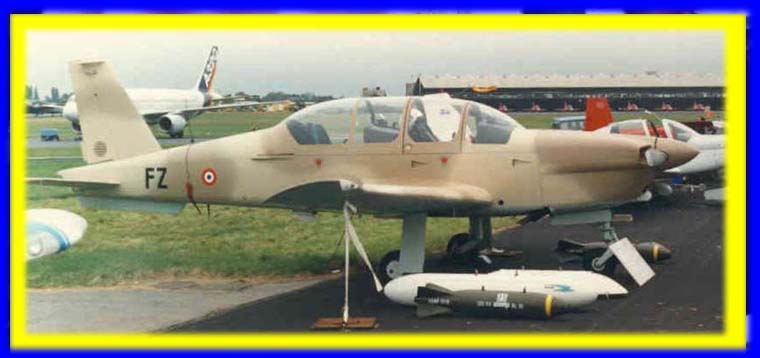 |
|
The Aerospatiale Epsilon (also known by its
company designation of TB30) is a tandem two seat light trainer used
primarily by the French armed forces. Powered by a 300hp Lycoming
engine, it has a top speed of 230mph and range of about 750 miles.
Since its first flight in December 1979, some 174 of them have been
built. It is 24 feet 7 inches long, with a 25 feet 9 inch wing span
and gross weight of 2,860lb. It has a couple of underwing hardpoints
for fuel tanks or practise bombs. This
one was at Farnborough in September 1986. |
|
|
The Fouga CM170 Magister was the world's
first purpose built primary jet trainer, having its first flight in
July 1952. Its V tail makes it very distinctive. It is powered by
two Turbomeca Marbore turbojets, each of 880 lb thrust, giving it a
top speed of 444mph and range of 575 miles. It is 33 feet long with
a wing span of 39 feet 10 inches, and maximum take-off weight of
7,050lb. All told, 918 were built, and used by a wide variety of air
forces. The French navy version was called the CM175 Zephyr, and the
Israeli forces called it the Zukit.
The top picture shows a Belgian Magister in
special anniversary colour scheme at Mildenhall, probably in the
late 1980s. The lower picture is of the Belgian air force's
aerobatic team, the Diables Rouges (Red Devils), at Finningley,
probably in 1976. |
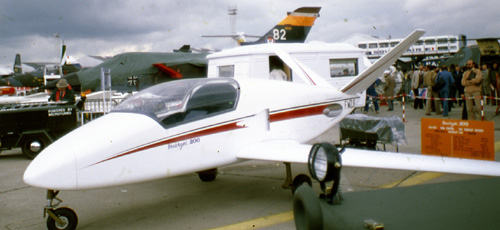 |
The Microjet 200 is a diminutive jet trainer,
only 21 feet 10 inches long and with a wing span of 24 feet 10
inches long. It is powered by two 290lb Microturbo jets. This gives
it a speed of 290mph and range of 450 miles. It first flew in June
1980. Only three were built; it proved underpowered for its intended
market.
This one was at
Paris, date uncertain |
|
France /
Germany |
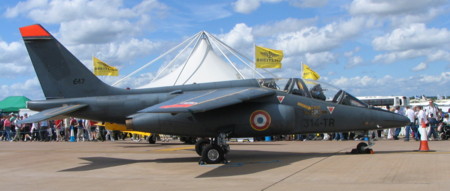 |
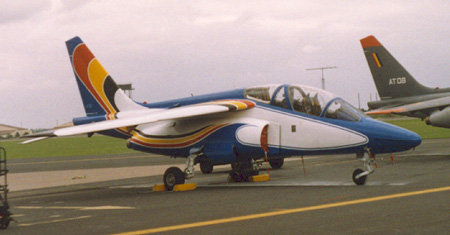 |
|
The Alpha Jet was a joint venture between
Dassault-Breguet in France and Dornier in Germany. It could
reasonably be considered a Continental equivalent of the British
Hawk, dating from a similar period (it first flew in October 1973).
Unlike the Hawk or the Aero L-39, though, it is a twin, being
powered by two Snecma (Turbomeca) Larzac turbofans, each of 2,970lb
thrust. Top speed is 570mph and range 360 miles. It is 43 feet 5
inches long, with a wing span of 29 feet 10 inches, and maximum
weight 17,640lb. It comes in two flavours: the `A', a light attack
variant used primarily by the German air force and equipped with a
cannon and five weapons hardpoints; and the `E' trainer variant used
by the French. About 500 have been built in total, including many
for export. The top one was at Fairford
in July 2007. The lower picture is a very brightly painted
Belgian air force machine at Mildenhall, date uncertain. |
|
India |
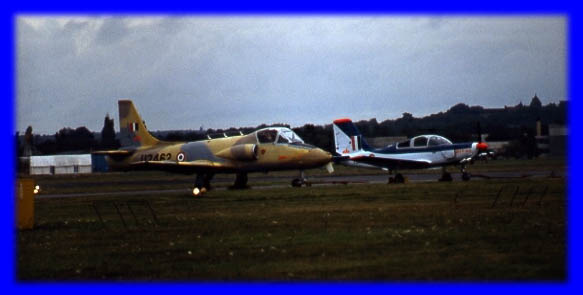 |
|
This picture shows the Hindustan Aeronautics
(HAL) Kiran & HTT34 lining up for takeoff together on a
very gloomy afternoon at Farnborough in September 1984. The Kiran,
which first flew in September 1964, was a basic jet trainer rather
like the Jet Provost, powered by a Bristol Viper turbojet. The
version pictured here is a Kiran mark 2, which first flew in July
1976, powered by a 4,130lb Orpheus engine. 118 mark 1s and 61 mark
2s were built. Both versions are 34 feet 9 inches ling, with wing
span of 35 feet 11 inches. Top speed is 430mph, and gross weight (of
the Mark 2) is 10,900lb. Only the mark 2 can carry armament, with
two Aden guns and four hardpoints. The
HTT34 was an unsuccessful attempt to produce a turboprop version of
the earlier HTT32 Deepak, with a 420shp Allison250 engine. It first
flew in June 1984. Only one was ever built before it was cancelled
due to lack of interest. |
|
Italy |
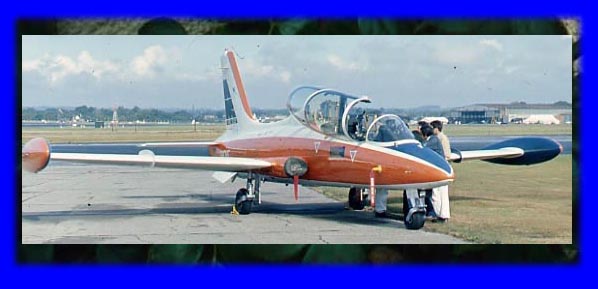 |
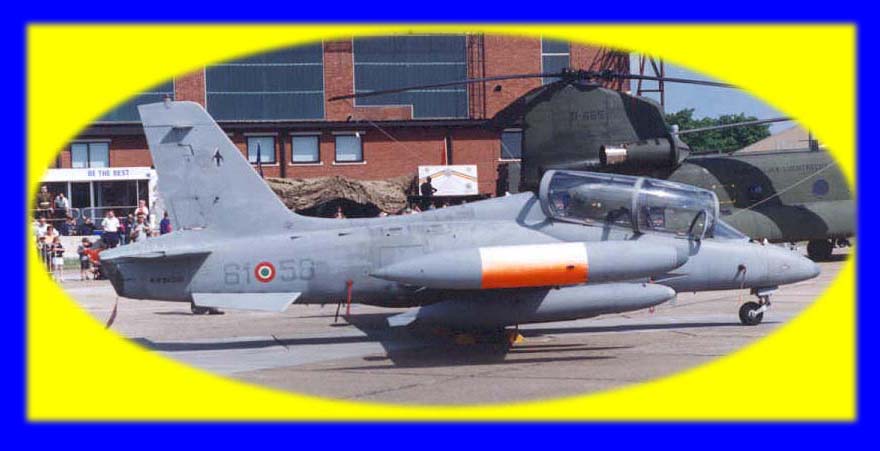 |
|
The Aermacchi Mb339 is Italy's tandem
advanced jet trainer. Powered by the capable Rolls-Royce Viper
turbojet, giving 4,400lb thrust, it manages 600mph and has a range
of 730 miles. It first flew in August 1976, and is operated by the
air forces of seven countries in addition to the Italians. A special
version without the wing tip tanks, the Mb339PAN, was built to equip
the Italian national aerobatic team, the Frecce Tricolori, replacing
their earlier Fiat G-91PAN. Its straight wings have a span of 36
feet 11 inches; fuselage length is 36 feet 10 inches. Maximum weight
is 14,000 lb. It is capable of carrying
light armament on six underwing stores points, either for the light
attack role or as a weapons trainer.
The top picture was taken at Farnborough in
September 1976, only a month after the type's first flight. The
lower picture shows an Italian air force example at Mildenhall in
1997. |
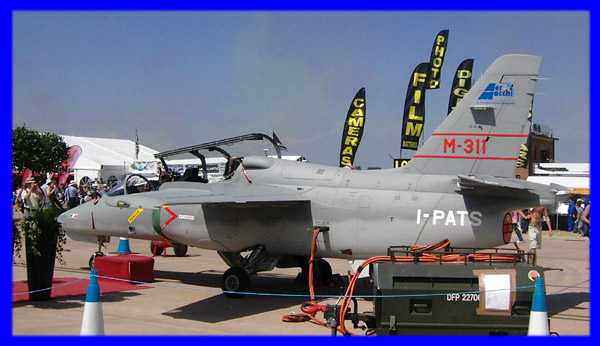 |
The Aermacchi M311 is a new design of primary
jet trainer, intended to supersede the Italian company's earlier
(and similar) S211 design. It competed unsuccessfully for the US Air
Force's Primary Aircrew Training System (hence the registration
I-PATS). This company demonstrator was
at Fairford in July 2005. |
|
Netherlands |
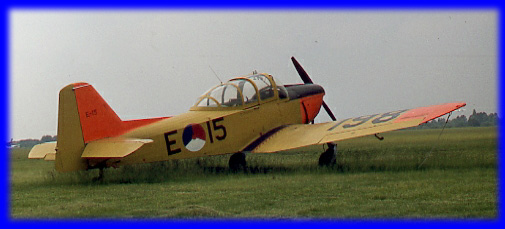 |
|
The Fokker S11 Instructor could almost be
considered a Dutch equivalent of the Percival Prentice. The
resemblance is superficial, however, because although they are of
similar vintage, the Instructor is a much smaller and more agile
aircraft. It is 26 feet 6 inches long and has a 35 foot 9 inch wing
span. Gross weight is 2,420lb, almost half that of the Prentice.
Powered by a 190hp Lycoming O-435 engine, it has a top speed of
135mph and range of 430 miles. 365 were
built, including 150 in Italy as the Macchi Mb416 and 100 in Brazil
as the T-21.
This former Dutch air force example was at
Denham in June 1984. |
|
Russia |
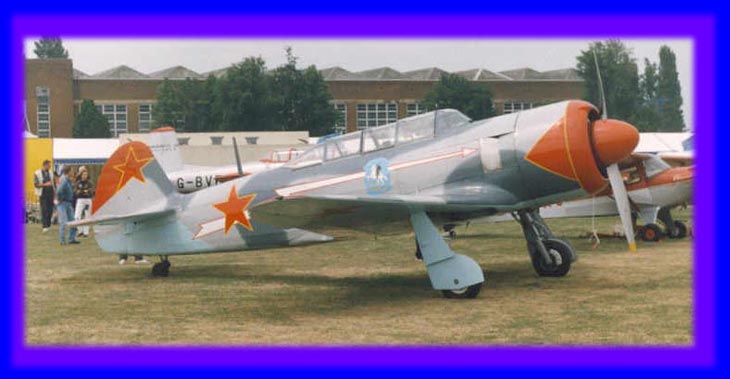 |
|
The Yakovlev YAK11 is blessed with the
singularly apposite NATO codename of `Moose'. It is a tough, rugged,
imposing machine, dominated by its 570hp Shvetsov Ash21 radial
engine, which gives it a superb top speed of 290mph. Unusually for a
Russian aircraft of the period (it first flew in 1946), it also has
an excellent range of 800 miles. At 27 feet 10 inches long, and with
the elegant thin wing being 30 feet 10 inches in span, it is
actually not quite as huge as it looks; but its gross weight of
5,740lb is telling. Its aerobatic performance is excellent,
especially in roll. Having been retired
from military service, a few are now in private hands, including
this one, seen at Cranfield, date uncertain. |
|
Spain |
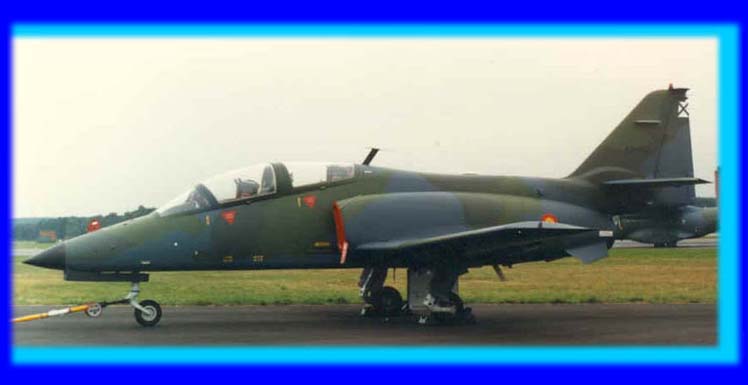 |
|
The CASA 101 Aviojet is the Spanish tandem
seat advanced trainer! Known in Spanish air force service as the
T-36, it competes with the Mb339 or the Hawk. Powered by a single
Garrett TFE731 turbofan giving 4,100lb thrust, it has a top speed of
410mph and range of 2,300 miles. Gross weight is 13,860lb. It is 40
feet 7 inches long, with a wing span of 34 feet 5 inches. For the
light attack role, it can be equipped with a cannon and has the
normal array of hardpoints to carry weaponry externally. From its
first flight in June 1977, 135 have been built, serving with the air
forces of Spain, Chile, Honduras and Jordan.
This Spanish air force example was at Farnborough
in 1986. |
|
Sweden |
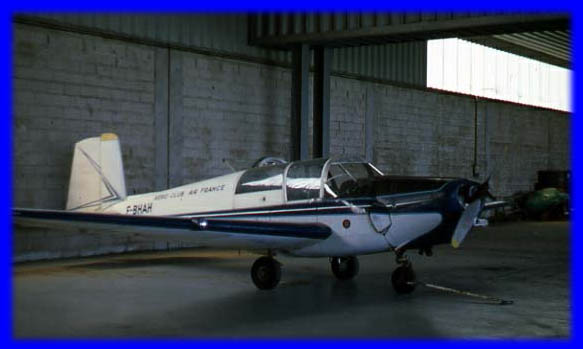 |
|
The SAAB 91 Safir is unmistakeable, with its
short stubby undercarriage and square tail. It was designed as a
three seat trainer and light liaison aircraft for the Swedish air
force, and first flew in November 1945. Various versions have been
powered by various engines, ranging from the initial 120hp De
Havilland Gipsy Major up to the 190hp Lycoming O-435. At 25 feet 7
inches long and having a wing span of 34 feet 9 inches, it is within
a few inches of being the same size as a Chipmunk, but at 2,370lb
gross weight it is significantly heavier. VNE is 215mph (though I
wouldn't like to try it), and range up to 400 miles. All told, 474
of these capable aircraft were built.
This one, operated by the Air France Aero Club, was at Toussus in
June 1979. |
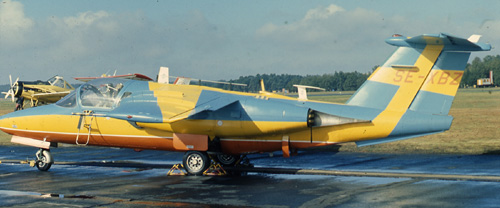 |
The SAAB 105 is a two seat jet trainer which
can also be modified to carry external stores. Its two 1,635lb
Turbomeca Aubisque engines (I haven't found another aircraft powered
by these - any offers?) give it a top speed of 470mph and range of
1,200 miles, with gross weight of 8,900lb. It is 35 feet 9 inches
long; its shoulder mounted wing spans 30 feet 10 inches. It first
flew in June 1963. 148 were built for the Swedish air force, plus 40
of an export version for Austria.
This company demonstrator was pictured on a beautiful day at
Farnborough, September 1976 |
|
Switzerland |
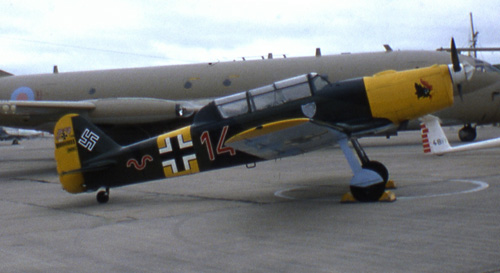 |
|
The Pilatus P-2 was the first of the
specialist trainers produced by this well known Swiss company. It
first flew in April 1945. It is powered by a meaty 465hp Argus
inline engine, which gives it a top speed of 210mph and range of 350
miles. It is heavy for its class, weighing in at 4,300lb, but this
does not stop it being a very effective performer. It is 29 feet 9
inches long, with a wing span of 36 feet 1 inch.
Following withdrawal from Swiss air force
service, several were sold to private operators. This one visited
Yeovilton in July 1986. |
|
|
The Pilatus PC7 Turbo-Trainer was one of the
first in the current generation of turbine powered initial trainers,
having its first flight in August 1978. It quickly established a
niche for the Swiss company in the training market, with around 500
having been built for 20 air forces. Its single 700shp Pratt &
Whitney PT6A turboprop engine gives it a cruising speed of 250kt and
range of 810nm. Length is 33 feet 3 inches and the wing span, almost
the same, 33 feet 5 inches. With a gross weight of 4,960lb, there is
enough power to lift a range of external stores on six hardpoints.
This company demonstrator was in fact an earlier
PC-3 which had been re-engined as a PC7 technology demonstrator; it
was at Farnborough in September 1976. |
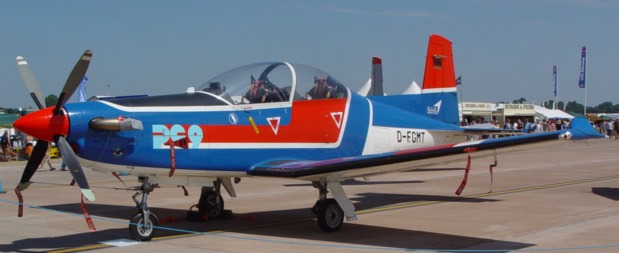 |
The Pilatus PC9 is essentially an upgraded
PC-7, the main differences being the more powerful 950shp engine,
and the stepped cockpit which gives the instructor better
visibility. The extra power increases the cruising speed to 270kt;
gross weight is 5,180lb. It first flew in July 1984. 270 have been
built for twelve air forces. In addition, the type (somewhat
modified) was entered for the US Air Force's PATS competition, in
partnership with Raytheon. It won; 780 are being built for the USAF
as the Raytheon T-6A Texan II.
This one was at
Fairford, July 2005
|
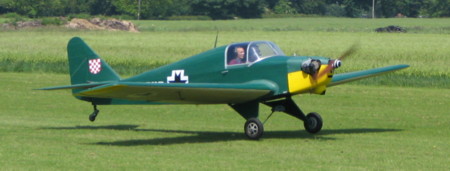
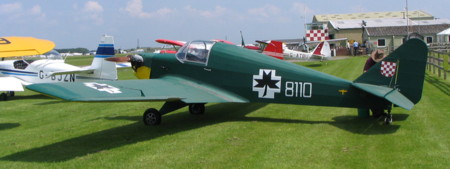 |
The Avia FL3 is a delightful little two seat
trainer made in the 1940s. In the literature there are conflicting
views of whether it was built in Italy or Yugoslavia, and the
maker's name (Azionara Vercellese Ind. Aeronautiche) can hardly be
more Italian, but in fact it was physically made in what is now
Croatia - hence the Croatian air force markings. Grossing only 525Kg
and with a tiny CNA D4 engine, this is definitely towards the basic
end of the training spectrum. This is
the only one in the UK. It was pictured at Breighton, June 2007. |





|